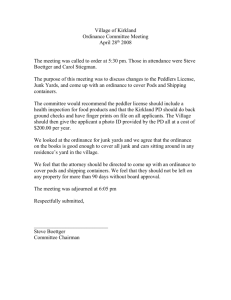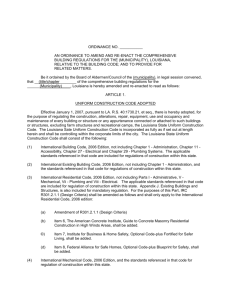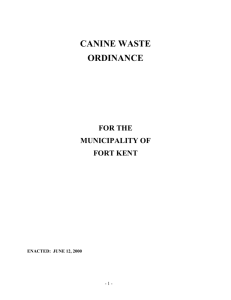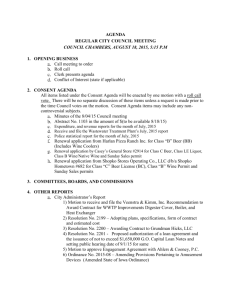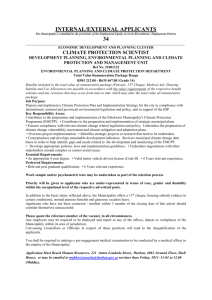1 THE SUPREME COURT OF APPEAL OF SOUTH AFRICA
advertisement
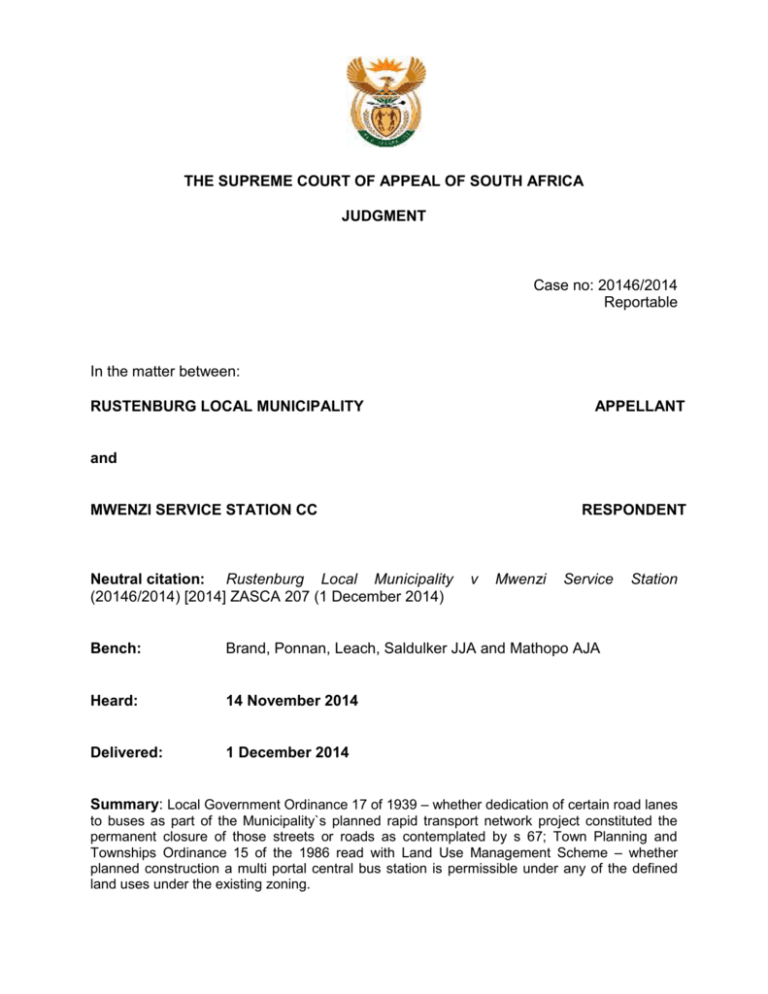
THE SUPREME COURT OF APPEAL OF SOUTH AFRICA JUDGMENT Case no: 20146/2014 Reportable In the matter between: RUSTENBURG LOCAL MUNICIPALITY APPELLANT and MWENZI SERVICE STATION CC Neutral citation: Rustenburg Local Municipality (20146/2014) [2014] ZASCA 207 (1 December 2014) RESPONDENT v Mwenzi Service Bench: Brand, Ponnan, Leach, Saldulker JJA and Mathopo AJA Heard: 14 November 2014 Delivered: 1 December 2014 Station Summary: Local Government Ordinance 17 of 1939 – whether dedication of certain road lanes to buses as part of the Municipality`s planned rapid transport network project constituted the permanent closure of those streets or roads as contemplated by s 67; Town Planning and Townships Ordinance 15 of the 1986 read with Land Use Management Scheme – whether planned construction a multi portal central bus station is permissible under any of the defined land uses under the existing zoning. 2 _____________________________________________________________________ ORDER ______________________________________________________________________ On appeal from: North West High Court, Mafikeng (Gutta J sitting as court of first instance) Save for paragraph (c) of the order of the court below, which is set aside, the appeal and the cross appeal are dismissed, with costs in each instance to follow the result. ______________________________________________________________________ JUDGMENT ______________________________________________________________________ Ponnan JA (Brand, Leach, Saldulker JJA Mathopo AJA concurring): [1] During 2007 the National Department of Transport tabled before Parliament a ‘public transport strategy and action plan’ that proposed the planning, design and development of integrated rapid transport networks in certain major urban centres in South Africa. The plan was approved by Cabinet and 12 cities, including Rustenburg, were identified where such networks were to be introduced. During 2008 the appellant, the Rustenburg Local Municipality (the Municipality), invited tenders for the investigation and development of such a network in Rustenburg. The following year the Rustenburg Integrated Network, a joint venture was appointed and commenced feasibility studies, the planning and design of the scheme, as well as the development of a financial and 3 operational model. In July 2011 the Rustenburg Rapid Transport (RRT) was officially launched by the Municipality. [2] By the middle of 2012 the initial planning and design of the RRT project was completed and construction commenced on its first phase, which included the widening of certain roads and the establishment of RRT lanes in some of the outlying areas of Rustenburg. It was contemplated that the project would then progress to the construction of the RRT network within the Rustenburg central business district (the CBD) including the construction of a central bus station on President Mbeki Drive between Nelson Mandela and Oliver Tambo Drives. It is the envisaged creation of the dedicated bus lanes and the plan to establish a central bus station in the CBD that has given rise to the dispute, the subject of the present appeal. [3] The respondent, Mwenzi Service Station CC (Mwenzi), conducts business as a BP franchisee on the corner of Nelson Mandela and President Mbeki Drives. Mwenzi accepts that the RRT project is ‘visionary’ and that it ‘in principle supports [the] project’. That notwithstanding on 19 January 2012 its attorney wrote to the Municipality: ‘My business is situated on the corner of Nelson Mandela and Pres Thabo Mbeki street, these are the two streets that the bus route will be on and during construction and after the implementation the traffic flow on and into my service station will greatly be affected in a negative way. At least 50% of my business will be lost during this time. By 2015 all taxis operating in the CBD will have ceased and only buses will be allowed. At the moment 40% of my business consists of taxis.’ 4 [4] Mwenzi accordingly sought compensation from the Municipality for the adverse effect that it alleged the establishment of the RRT would have on its business. On 13 August 2012, and after an exchange of correspondence and several meetings between the parties had proved fruitless, the Municipality informed Mwenzi that it was not entitled to compensation. As a result on 28 March 2013 Mwenzi applied to the North-West High Court, Mafikeng for an order in the following terms: ‘1. The Respondent is ordered to comply with the provisions of section 67 of Local Government Ordinance 17 of 1939, in the public street closures and/ or the diversion of streets that are required for the implementation of the Rustenburg Rapid Transport Network. 2. The Respondent is ordered to comply with the Town Planning and Township Ordinance 15 of 1986 read together with the Rustenburg Town Planning Scheme 2005 as far as the rezoning of public streets that are to be public buildings, in the Rustenburg Rapid Transport Network. 3. That the respondent is restrained from the further implementation of the RRT in the CBD of Rustenburg pending compliance with orders 1 and 2 above.’ [5] In support of the relief sought, Mwenzi contended that the dedication of certain road lanes to buses as part of the Municipality`s planned RRT project constituted the permanent closure of those streets or roads as contemplated by s 67 of the Local Government Ordinance 17 of 1939 (the 1939 Ordinance) and that, as a consequence, it was accordingly entitled to compensation in terms of s 67(4). In the alternative, Mwenzi contended that the planned construction of the multi portal central bus station (CBS) with ancillary amenities (such as offices, ticket and information booths, storage facilities and sheltered passenger waiting areas) on the median of President Mbeki Drive is not permissible under any of the defined land uses in terms of the existing zoning. It 5 accordingly contended that the Municipality was obliged to rezone that portion of land in terms of the Town Planning and Townships Ordinance 15 of the 1986 (the 1986 Ordinance) read with the Rustenburg Land Use Management Scheme (the Scheme), which as well would entitle it to compensation in terms of s 44 of that Ordinance. [6] Two issues thus arose for determination before the high court (as also before this court on appeal) namely: first, whether the Municipality is obliged to comply with s 67 of the 1939 Ordinance before it can reserve or dedicate street lanes to buses providing public transport in the Rustenburg CBD; and second, whether it is necessary for the Municipality to rezone President Mbeki Drive between Nelson Mandela and Oliver Tambo Drives before it may construct the planned CBS on the island or median of that road. [7] The high court (per Gutta J) decided the first issue in favour of the Municipality and the second issue against it. It accordingly ordered the Municipality to comply with the 1986 Ordinance read with the Scheme ‘for the rezoning of the President Thabo Mbeki Street for the establishment of the [CBS] in the [RRT] Network’ and interdicted it from ‘implementing and establishing the [CBS] in the Rustenburg [CBD] pending compliance with [that order]’. The Municipality was ordered to pay the costs of the application. The high court granted leave to: (a) the Municipality to appeal against those orders; and (b) Mwenzi to cross-appeal its conclusion that it was not entitled to compensation in terms of s 67 of the 1939 Ordinance. 6 As to the first issue [8] A useful starting point is sections 66 to 68 of the 1939 Ordinance. They provide: ‘66. Closing of certain public places. (1) Notwithstanding anything to the contrary contained in this Ordinance, a council may, after having given such notice as it may deem necessary ... (b) close any street, road or thoroughfare vested in the council (i) permanently or temporarily for any particular class of traffic, procession or gathering; or (ii) temporarily for all traffic; or ... 67. Permanent closing or diversion of street. Notwithstanding anything to the contrary in this Ordinance contained the council may permanently close or divert any street or portion of a street if and when the following conditions have been compiled with: ... (4)(a) Any person who considers that his interests will be adversely affected by the proposed closing or diversion may at any time before the time for the lodging of objections and claims has expired, lodge with the council a claim, in writing, for any loss or damage which will be sustained by him if the proposed closing or diversion is carried out. If such closing or diversion is carried out the council shall pay compensation for the damage or loss sustained by such person, the amount of compensation in default of mutual agreement to be determined by arbitration. In assessing the amount of compensation the benefit or advantage derived or to be derived by the claimant by reason of the closing or diversion shall be taken into account. If such person however, fails to lodge his claim with the council during the period during which objections and 7 claims may in terms of paragraph (3) of this section be lodged he shall not be entitled to any compensation for any damage or loss sustained by him. (b) If the council finds that the payment of compensation will be too costly, it may resolve not to proceed with the proposed closing or diversion. ... 68. Permanent closing of squares, open spaces, gardens, parks or other enclosed spaces. Notwithstanding anything to the contrary contained in this Ordinance, the Council may close permanently, either in whole or in part, any square, open space, garden, park or other enclosed space, vested in the council under section 63: Provided that the provisions of section 67 shall mutantis mutandis apply to the council in the exercise of the power hereby conferred.’ [9] Section 66(1)(b)(i) of the 1939 Ordinance empowers a local authority after having given such notice as may be necessary to 'permanently or temporarily' close any street for any ‘particular class of traffic’, whilst s 67 empowers it to ‘permanently close or divert’ any street (or portion of a street) when certain conditions set out in the succeeding subsections are complied with. The Municipality admits that it did not comply with the conditions prescribed by s 67 because, so it contends, it did not effect a permanent closure or diversion. Accordingly, so the contention goes, considerations of compensation do not even arise and Mwenzi is not entitled to compensation in terms of s 67(4). Unlike s 66, s 67 requires inter alia: (a) a proposal for the closing or diversion of a street to be dealt with at a meeting of the relevant local authority (subsec (1)); (b) a plan showing the proposed closure or diversion (subsec (2)); and (c) publication of the plan (in the Provincial Gazette, one English and one Afrikaans language newspapers 8 and by the posting of notices in a conspicuous manner at or near the street proposed to be closed and the service of notices on the owners of all properties abutting the street proposed to be closed) and the inviting of objections, if any (subsec (3)). Section 67 further prescribes the necessary procedures for dealing with objections and claims for compensation. Section 66 on the other hand requires a local authority to do no more than give such notice as it may deem necessary. Significantly, the fairly onerous notice, public participation and compensation provisions set out in s 67 find application in one further instance, namely, the permanent closure of ‘squares, open spaces, gardens, parks or other enclosed spaces’ in terms of s 68. Thus where the legislature intended that a local authority comply with those requirements it expressly said so. [10] ‘Street’, according to the 1939 Ordinance, includes ‘any street, road or thoroughfare shown on the general plan of a township . . . or in respect of which the public has acquired a prescriptive or other right of way’. The Ordinance contains no definition of the words 'close' or ‘divert’ and s 67 does not appear to limit them in any way. According to the Concise OED the verbs ‘close’ and ‘divert’, inter alia, mean: ‘cease to be open to the public or in operation’; and ‘cause to change course or take a different route’. Self-evidently the words ' permanently close or divert' in s 67 of the 1939 Ordinance qualifies the words 'any street or portion of a street' which follow immediately thereafter. The verb 'close' qualified as it is by the word ‘permanently’ must thus in the context of s 67 mean 'permanently close to all traffic'. It thus seems plain that in enacting sections 66 and 67 the legislature intended to cater for two distinctly different scenarios. Accordingly, different provisions apply to the closing of any street 9 permanently for any particular class of traffic, procession or gathering (s 66) and the closing of any street or a portion of a street permanently for all classes of traffic (s 67). (See SJ and MM Hilcove (Pty) Ltd T/A Kentucky Fried Chicken & another v Pietermaritzburg City Council 1988 (3) SA 319 (A) at 328I-J.) [11] It is accordingly necessary to enquire whether the RRT project will result in the closing of any street permanently for all classes of traffic as contemplated by s 67. The plan for the establishment of the RRT in the CBD of Rustenburg involves the reserving or dedication of two out of three lanes in each direction on President Mbeki Drive and two out of four lanes in each of Nelson Mandela and Oliver Tambo Drives to RRT buses. The remaining lanes of each of these roads will remain open to mixed traffic. Mixed traffic will not be able to utilise the dedicated bus lanes. The dedicated bus lanes in President Mbeki Drive will be separated from the mixed traffic lanes by being raised in order to assist with the embarkation and disembarkation of passengers at the CBS. Elsewhere, the dedicated bus lanes are on the same level as the mixed traffic lanes, but the one is separated from the other by lane delineators. At intersections, however, there is no separation because the delineators stop before and do not run into intersections. In addition, in respect of the intersection between Nelson Mandela and President Mbeki Drives (in front of Mwenzi`s service station) and the intersection of Oliver Tambo and President Mbeki Drives, the design is such that the whole of those intersections are raised, including the mixed traffic lanes. This is because the raised intersections are preceded in the throughways by five metre long gradual gradients specifically designed to facilitate ease of traffic flow and also to accommodate mobility impaired persons and 10 vehicles. The intersections of Nelson Mandela and President Mbeki Drives, on the one hand, and Oliver Tambo and President Mbeki Drives on the other, will in addition be controlled by phased traffic lights to ensure safe and smooth flow of traffic and the crossing of dedicated bus lanes by ordinary traffic. Mwenzi’s service station presently has four access points – two in each of Nelson Mandela and President Mbeki Drives. It is not in dispute that the RRT will not affect any of those access points. [12] On its plain meaning the words 'permanently close or divert any street or portion of a street' can hardly find application in circumstances where all that is hoped to be achieved is the simple alteration of traffic flows on a street. Nor, in my view, does it apply to a situation such as this, where the establishment of dedicated bus lanes will result in the reserving of no more than just a portion (not the whole) of those streets for the exclusive use of buses, notwithstanding how adversely that may affect a particular party such as Mwenzi in this case. As other vehicular traffic will continue to have unrestricted access to the remaining portions of those streets, the reserving of dedicated bus lanes for the exclusive use of buses, will not amount to a closing of streets (or even a portion of those streets) permanently to all classes of traffic as contemplated by s 67. On the contrary that is the very situation contemplated by s 66(1) (b)(i), namely the permanent closure of a part of a street for a particular class of traffic. It must thus follow that s 67 of the Ordinance does not find application. As to the second issue: 11 [13] The principal tool for regulating land use is through the introduction and enforcement by a municipality of a town planning scheme (Johannesburg Municipality v Gauteng Development Tribunal & others 2010 (2) SA 554 (SCA). In terms of the 1986 Ordinance the general purpose of a town planning scheme is the co-ordinated and harmonious development of the area to which it relates as will most effectively, inter alia, promote the safety, good order and general welfare of such area (s 19). The Ordinance contemplates detailed control and regulation of land use being exercised by a municipality. The Scheme regulates land use in Rustenburg. It does so by means of zoning, which is essentially the ‘allocation of different uses to different areas (Van Wyk ‘Planning Law; Principles and Procedures of Land-Use Management at 39). As it was put by Human J in Pick `n Pay Stores Ltd & others v Teazers Comedy & Revue CC & others 2000 (3) SA 645 (W) at 656H: ‘Zoning is an aspect of town planning which is primarily concerned with certain restrictions or limitations on ownership and use of land. For this reason zoning is a limitation or condition restricting the exercise of ownership.’ And at 656G: ‘Such purpose would be frustrated if a use were allowed for which no provision is made in the town planning scheme or if a person uses land contrary to the purpose for which it is zoned.’ [14] The Scheme imposes restrictions on the use of land. Section 2.1 provides that ‘no land or building may be used for any purpose other than that permitted in this Scheme’. And s 3.3 prohibits the use, without consent, of ‘any land, building or part 12 thereof for a purpose other than the purpose for which it was zoned’. President Mbeki Drive is zoned ‘existing public road’. A street or road is defined in the Scheme as: ‘the area or part of any street, road, bridge, subway, avenue, lane, sanitary lane, thoroughfare or right-of-way, as shown on the general plan of a township or agricultural holdings or division of land in respect of which the public has acquired a prescription or other right-of-way.’ There are nine defined land uses permitted by the Scheme under the zoning existing public roads, namely, cultural heritage site, electrical purposes, municipal purposes, proposed roads, protected areas, railway purposes, street or road, taxi rank and telecommunication. The Municipality contends that the planned CBS falls within the scope of two such uses, namely taxi rank and municipal purposes. Each of those will be considered in turn. [15] In the Scheme, the land use ‘taxi rank’ is defined as ‘a place at which mini busses (taxis) and busses are allowed to wait and/or stop for passengers boarding or alighting’. The Scheme makes provision as well for: (a) a taxi holding area, which is defined as ‘an area, usually off-street, where mini buses (taxis) hold before proceeding to loading points and where generally there is no passenger activity. A holding area can either be included within or separate from a Taxi rank; and (b) a taxi parking area, which is defined as ‘a demarcated part of a parking lot which may be used by minibuses (taxis) aiming to provide a public transport service.’ None of those related land uses contemplate the erection or use of buildings unlike for example uses such as ‘electrical purposes’, ‘railway purposes’ and ‘telecommunications’ - each of which are defined to mean ‘the use of land or a building designed or used for [that particular purpose]’. 13 [16] The Municipality contends that plans to build the CBS are incidental to or legitimately part of the expressly sanctioned use. In Coin Operated Systems v Pty Ltd & another Johannesburg City Council 1973 (3) 856 (W) at 860E Margo J stated: ‘The test of whether the use claimed by the applicants is lawful or unlawful is therefore not simply whether the premises are being used for business activities. The test is whether the use in question is legitimately part of, or incidental to, one or other of the uses or activities included in the definition of “residential building”. (See also Clarensville (Pty) Ltd v Cape town Municipality 1974 (4) 974 (C) at 978G) The Scheme, however, expressly states when a particular use is to be regarded as incidental to or legitimately part of the main use as defined. Thus for example: (a) ‘agriculture’ is defined as ‘land that is used or intended to be used for buildings and land uses associated with farming practices . . .’; (b) builders yard includes ‘administrative offices incidental to [the mentioned uses]; (c) ‘commercial use’ includes ‘offices that are subordinate and complementary to the commercial use of the land’; (d) ‘dwelling unit’ includes ‘such outbuildings and servants quarters as are ordinarily incidental therewith; and (e) ‘funeral parlour’ includes ‘such other buildings designed for use in connection therewith and is normally ancillary to or reasonably necessary for the business of a funeral undertaker’. It must follow from this that an express permission could easily have been provided for had that been intended. Moreover, the multi portal CBS encountered could hardly be described as being incidental to or legitimately part of the main use of a taxi rank as defined. In addition, the Scheme caters elsewhere for the transportation of passengers. That it does under ‘transport uses’, which means: ‘the use of land and / or buildings for the operation of a business consisting of the transportation of goods and/ or passengers by rail, air, road and pipelines and includes uses such as stations, 14 transportation amenities and facilities, parking, administrative offices and ancillary uses such as warehouse, container parks, workshops as well as residential uses such as amenities for personnel, and may further include any uses such as shops or offices which are of service and convenience to passengers, as approved by the Local Authority.’ [17] ‘Municipal purposes’ is defined in the Scheme to mean ‘such use of land for which the Local Authority is authorised in terms of any law or ordinance and which the Local Authority may approve from time to time’. On a proper interpretation of this definition the actual use of the land by the Municipality must be authorised in terms of any law or ordinance. It can therefore hardly be said to assist the Municipality. Here too, the definition does not encompass buildings. By contrast government purposes does. The Scheme defines government purposes as: ‘land used or buildings designed or used for government or municipal purposes which may include communal facilities provided by the Government or the Local Authority.’ [18] It must follow that the planned construction of the CBS on President Mbeki is not authorised or permitted by the Scheme under its present zoning - ‘existing public road’. Accordingly, a rezoning thereof would be required in terms of s 56 of the 1986 Ordinance. Whether that would entitle those who may be adversely affected by such rezoning to compensation in terms of s 44 of that Ordinance need not here detain us. [19] Paragraph (c) of the high court order interdicted the Municipality from implementing and establishing the CBS in the Rustenburg CBD pending compliance with the 1986 Ordinance read with the Scheme. Since Mwenzi failed to establish that it 15 would suffer any harm (much less irreparable harm) in consequence of such failure on the part of the Municipality, there was no warrant for the interdict that issued. The setting aside of the interdict does not improve the position of the Municipality – it remains bound by the principle of legality to comply with the Ordinance and the Scheme. Nor would its discharge have any impact on the costs of the appeal. It follows that that order falls to be set aside. For the rest, the judgment of the high court must stand. [20] In the result save for paragraph (c) of the order of the court below, which is dismissed, the appeal and the cross appeal fail, with costs in each instance to follow the result. _________________ V PONNAN JUDGE OF APPEAL 16 APPEARANCES: For Appellant: M C Maritz SC (with A J D`Oliveira) Instructed by: Kgomo Mokhetle & Tlou Attorneys Mahikeng c/o McIntyre & Van der Post Attorneys Bloemfontein For Respondent: M M Oosthuizen SC Instructed by: Smit Stanton Inc Mahikeng c/o Zietsman-Horn Attorneys Rustenburg c/o Symington & De Kok Attorneys Bloemfontein

